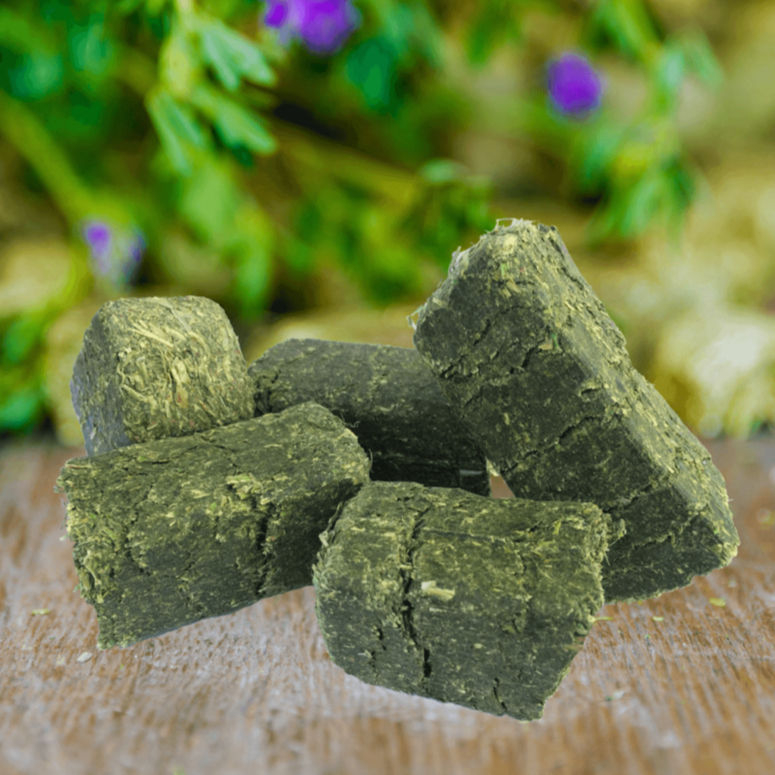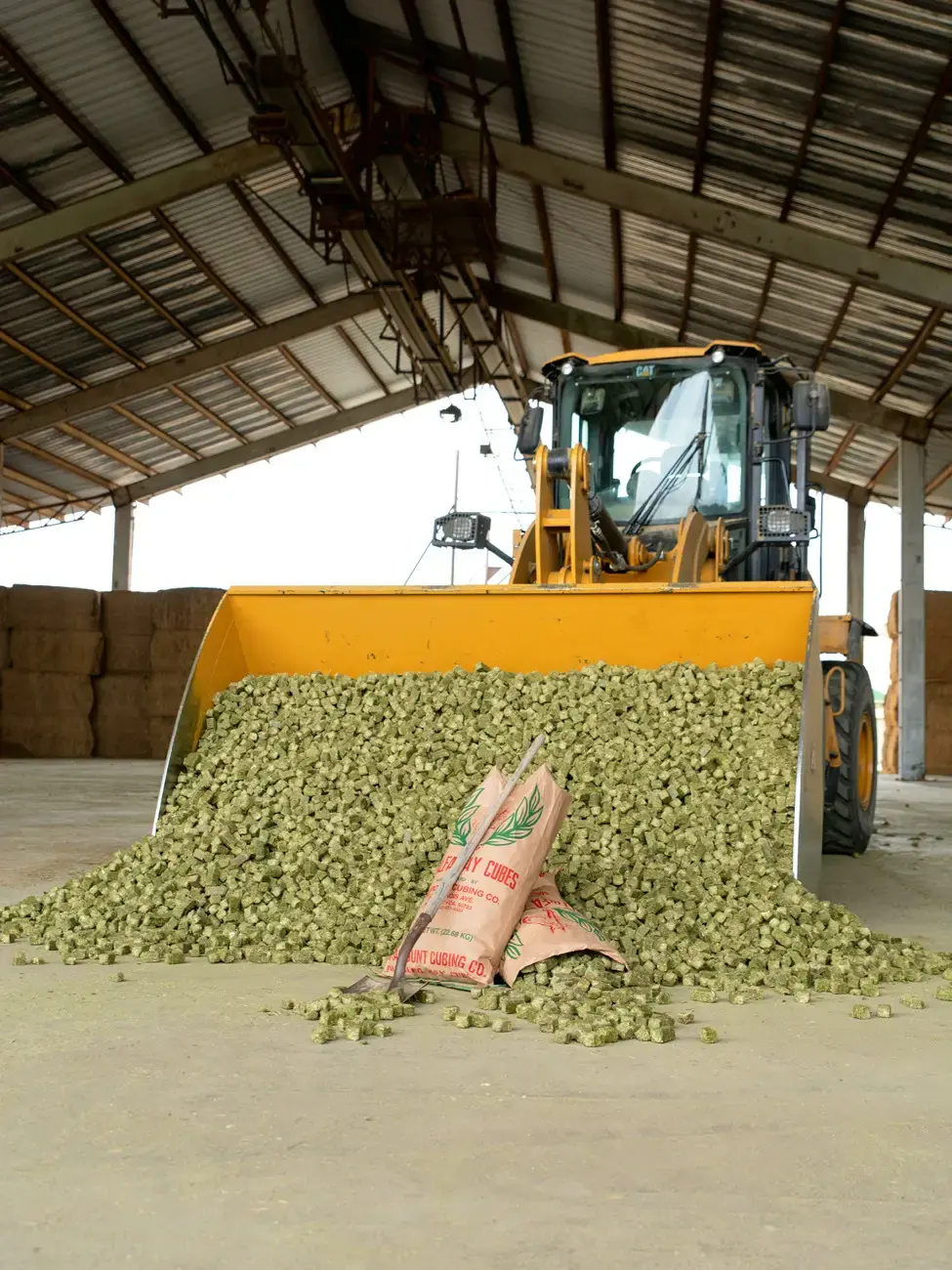Everything to Know About Hay Cubes for Horses
- McKenna Hines
- Jul 5
- 10 min read
Updated: Aug 22

Whether you're a seasoned horse owner or just starting your journey, this comprehensive guide covers everything you need to know about hay cubes for horses—from benefits to feeding strategies and common misconceptions.
What Are Hay Cubes?
Hay cubes are compressed blocks made from chopped and dried forage, typically alfalfa, timothy, or a combination of grass hays. These cubes are designed to offer the same nutritional benefits as long-stem hay but in a more compact, manageable form.
The process involves drying the hay and compressing it under high pressure to form dense, uniform cubes. This method preserves nutritional value and extends shelf life, making it an ideal option for many horse owners.

Hay cubes are often used in areas where high-quality baled hay is difficult to source or store. They offer consistency in nutritional content and are less likely to contain mold or dust, which can irritate a horse’s respiratory system.
Mad Barn says, “Forage should constitute the bulk of your horse’s diet, but not all of it needs to be provided as long-stemmed forages like baled hay. Forage cubes and pellets are other options that may be beneficial for horses in different management situations.”
For horses with dental problems or special feeding needs, hay cubes for horses can provide an easier-to-chew alternative. Soaking them in water helps reduce the risk of choke and improves palatability.
Overall, hay cubes for horses are a versatile forage solution that fits into a wide range of equine diets and management systems.
Nutritional Value of Hay Cubes
One of the major advantages of hay cubes is their consistent and predictable nutritional profile. Each cube provides a measurable and often superior amount of nutrients compared to some baled hay, depending on the forage type used.
Hay cubes for horses often contain high levels of digestible fiber, protein, and essential vitamins and minerals, especially if made from alfalfa. This makes them ideal for horses with higher caloric or protein needs, such as broodmares and performance horses.
The nutritional uniformity of hay cubes allows for better ration balancing. Unlike baled hay, where nutrient levels can vary greatly between bales or even within the same bale, cubes offer dependable values.
Testing for nutrient content is easier and more reliable with cubes, aiding horse owners in creating a tailored diet. This can lead to improved health outcomes and more efficient feeding practices.
Choosing the right type of hay cubes for horses, whether alfalfa, grass, or a blend, is essential to match your horse’s specific nutritional requirements.
Benefits of Using Hay Cubes
There are several compelling reasons to consider integrating hay cubes for horses into your feeding program. One of the primary benefits is space efficiency—hay cubes take up significantly less storage room than traditional baled hay.
Hay cubes also reduce waste. Horses tend to scatter or trample loose hay, especially when fed on the ground. Cubes, on the other hand, are easier to manage and typically leave less mess behind.

For horses with respiratory issues, hay cubes for horses are a dust-free alternative when soaked, which helps minimize the risk of developing conditions like heaves or allergies.
The reduced bulk and uniform shape of cubes make them easy to transport and portion out. This is particularly helpful for boarding facilities, travel, or temporary stabling situations.
Canter Craze says, “Hay cubes are designed to mimic the nutritional of traditional hay, while also offering several advantages in terms of convenience and ease of feeding.”
Another major benefit is their shelf stability—properly stored hay cubes can last much longer without losing nutritional value or developing mold.
Comparing Hay Cubes to Baled Hay
When comparing hay cubes for horses to traditional baled hay, there are key differences in form, feeding experience, and handling. Both options can serve a horse well if chosen and managed correctly.
Baled hay provides long-stem fiber, which helps promote chewing and saliva production—important for digestive health. Hay cubes, while smaller, still offer effective fiber but in a processed form.
One potential downside of hay cubes is the risk of choke, especially if fed dry. This can be mitigated by soaking cubes before feeding, particularly for older horses or those prone to eating too quickly.
Hay cubes are more uniform in quality and reduce the variability often found in different bales of hay. This consistency is valuable in managing horses with specific dietary needs.
While both are valid forage options, hay cubes for horses offer more flexibility in certain situations, particularly when dealing with space constraints or specialized feeding requirements.
How to Feed Hay Cubes
Feeding hay cubes for horses involves different considerations than feeding loose hay. For one, determining the correct quantity is crucial to ensure your horse gets enough fiber and calories.
Start by weighing your cubes to provide an accurate daily ration—generally 1.5–2.5% of your horse’s body weight in total forage, including cubes and other hay sources.

Cubes can be fed dry or soaked, though soaking is often recommended for horses with dental problems, senior horses, or those at risk of choking. Simply add warm water and let them soak for 15–30 minutes until soft.
Cubes can be fed alone, mixed with grain, or used as part of a mash. They’re ideal for horses that bolt their feed, as the soaked mixture encourages slower consumption.
Whether as a complete forage replacement or a supplement to baled hay, hay cubes for horses can be easily integrated into a balanced diet with proper planning.
Soaking Hay Cubes: When and Why
Soaking hay cubes for horses is a common and often necessary practice, especially for horses with specific health needs. Soaking helps reduce the risk of choke, a condition where feed becomes lodged in the esophagus.
For senior horses or those with dental problems, soaked hay cubes are easier to chew and digest. They’re soft, palatable, and require less effort than long-stem hay or dry cubes.
Soaking also increases water intake, which can be especially helpful in dry climates or during the winter months when horses may be less inclined to drink. This added hydration supports digestion and helps prevent colic.
To soak hay cubes, simply mix with 1–2 parts warm water and let sit for 15–30 minutes. The result is a mash-like consistency that’s safe and enjoyable for most horses.
Using soaked hay cubes for horses as a complete or partial hay replacement provides both nutrition and hydration in one convenient feeding method.
Hay Cube Varieties: Alfalfa, Grass, and Blends
There are different types of hay cubes for horses, each with distinct nutritional profiles. The most common varieties are alfalfa cubes, grass hay cubes (such as timothy or orchard), and mixed cubes.

Alfalfa cubes are high in protein and calcium, making them ideal for performance horses, lactating mares, and growing foals. They are energy-dense and support muscle development and weight gain.
Grass hay cubes, on the other hand, are lower in protein and calories. These are better suited for easy keepers, senior horses, or those on restricted diets due to metabolic conditions.
Mixed hay cubes combine the benefits of both types, offering a balanced approach that suits a wider range of horses. They’re often used to maintain condition without overloading on protein.
Choosing the right type of hay cubes for horses depends on your horse’s age, activity level, health status, and existing diet. Always consider nutrient content when selecting a variety.
Hay Cubes for Senior Horses
Senior horses often struggle with dental wear, making it difficult to chew long-stem hay. Hay cubes for horses are a fantastic alternative for maintaining nutrition in aging equines.
When soaked, hay cubes are soft and easy to eat, even for horses missing teeth. This ensures older horses can still receive necessary fiber, calories, and nutrients without discomfort.
Because hay cubes can be measured and soaked precisely, they reduce the risk of digestive issues and allow for better control over nutrient intake.
Many commercial senior feeds incorporate hay cube components or recommend adding soaked cubes to support weight maintenance and hydration.
For geriatric horses, hay cubes for horses often represent a safer, more digestible, and practical feeding solution than traditional hay.
Addressing the Risk of Choke
One of the primary concerns with feeding hay cubes for horses is the potential for choke, particularly if the cubes are fed dry and the horse eats too quickly.
Choke occurs when food becomes lodged in the esophagus, causing distress and requiring veterinary intervention. This condition is more likely in horses that bolt their food or have dental problems.
To prevent choke, soaking cubes thoroughly is the best solution. Additionally, feeding from a shallow pan, adding large rocks to the feed tub, or using slow feeders can encourage slower consumption.
It’s also wise to observe your horse during feeding, especially when first introducing hay cubes, to ensure they’re chewing and swallowing appropriately.
By taking these precautions, you can safely include hay cubes for horses in your feeding routine without compromising your horse’s health.
Hay Cubes vs. Hay Pellets
While hay cubes for horses and hay pellets are both compressed forage products, they differ in size, texture, and how they're fed. Each has its pros and cons depending on your horse's needs.
Hay pellets are smaller, often requiring less chewing and soaking time, which is ideal for horses with severe dental issues or difficulty chewing larger particles.

Hay cubes, being larger, take longer to consume and mimic the chewing behavior seen with traditional hay, aiding in saliva production and digestion.
Both forms can be soaked, although hay pellets break down faster. However, pellets are more likely to be eaten quickly, which can increase the risk of choke in some horses.
Choosing between pellets and hay cubes for horses depends on your priorities—ease of feeding, chewing behavior, digestion, and horse preference all play a role.
Storing and Handling Hay Cubes
Proper storage of hay cubes for horses is essential to maintain their nutritional integrity and prevent mold or spoilage. Like any feed, cubes should be kept in a cool, dry, and clean environment.
Store hay cubes in bins with secure lids to prevent contamination from pests and moisture. Avoid stacking bags directly on the floor; instead, use pallets or shelving to improve air circulation.
Keep hay cubes away from direct sunlight and avoid extreme temperature fluctuations, which can compromise their quality and shelf life.
Check bags regularly for signs of mold, mildew, or unusual odors. If contamination occurs, discard the affected feed immediately.
Maintaining the quality of your hay cubes for horses through proper storage ensures your animals receive safe, clean, and nutritious feed every time.
Feeding Hay Cubes During Travel
Traveling with horses presents unique feeding challenges. Hay cubes for horses offer a compact, convenient solution that makes feeding on the go much simpler.
Unlike baled hay, which can be bulky and messy in a trailer or temporary stabling situation, hay cubes are neat, easy to store, and portion out as needed.
You can soak hay cubes at your destination or even pre-soak them in containers to bring along, ensuring your horse stays hydrated and stress-free during transit.
Providing familiar feed during travel can reduce anxiety and prevent digestive upset. Hay cubes allow you to offer consistent nutrition without relying on unknown or inconsistent local hay sources.
Whether you're trail riding, competing, or relocating, hay cubes for horses make it easier to keep your horse’s nutrition stable and reliable on the road.
Using Hay Cubes for Weight Management
Hay cubes for horses are a valuable tool for managing equine weight, whether your horse needs to gain or maintain condition. Their dense nutrient profile allows for efficient caloric intake.

For underweight horses, alfalfa-based cubes provide a concentrated source of energy and protein, supporting muscle development and healthy weight gain.
Cubes allow for precise control over portion sizes, making it easier to tailor the diet to the individual horse. This is especially important for hard keepers or performance horses in intense training.
For overweight horses, grass hay cubes can offer controlled fiber without excessive calories. When combined with slow feeding strategies, they help prevent overeating.
By selecting the appropriate type and amount, hay cubes for horses offer a customizable solution to both weight gain and calorie restriction.
Cost Considerations
Cost is a factor for every horse owner. While hay cubes for horses may seem more expensive per pound than baled hay, they often reduce overall waste and provide better nutrient efficiency.
The predictability of hay cubes allows for more precise feeding, which can lower the need for additional supplements or feeds to fill nutritional gaps.
Because hay cubes are easier to store and manage, they may save money on storage infrastructure, spoilage losses, or pest control.
For some regions where quality baled hay is scarce or expensive, cubes may actually represent a more economical choice in the long run.
Evaluating the true cost of hay cubes for horses involves considering their nutritional density, reduced waste, and practical advantages—not just the price per bag.
Are Hay Cubes Right for Your Horse?
Ultimately, whether hay cubes for horses are the right choice depends on your individual horse’s needs, your feeding setup, and your goals as a horse owner.
For horses with dental issues, respiratory sensitivity, or special feeding requirements, hay cubes offer solutions that traditional hay may not accommodate.
They can serve as a complete forage replacement, a supplement, or a temporary solution when traveling or during hay shortages.
Consult with your veterinarian or an equine nutritionist when introducing hay cubes, especially if your horse has health conditions or you’re making a major dietary change.
With the right approach, hay cubes for horses can be a safe, effective, and convenient way to support long-term health, performance, and well-being.
Making the Most of Hay Cubes for Horses
Hay cubes have emerged as a smart, versatile, and nutrition-packed solution for horse owners seeking better control, consistency, and convenience in their feeding programs. Whether you’re addressing dental issues, managing weight, preparing for travel, or simply aiming to reduce hay waste, hay cubes for horses offer practical advantages that traditional forage sometimes can't match.

From their reliable nutritional value to ease of storage and feeding flexibility, hay cubes provide a level of precision and accessibility that benefits horses of all ages and needs.
They are particularly valuable for senior horses, performance athletes, and those in environments where baled hay is less available or cost-prohibitive.
As with any dietary decision, the key to success is proper planning. Matching the right type of hay cube to your horse's health status, soaking when necessary, and monitoring for changes in condition ensures you get the most from this forage option.
Consulting with a veterinarian or equine nutritionist can further help tailor your use of hay cubes to your horse’s unique needs.
In the end, hay cubes for horses are more than just a convenient alternative—they’re a reliable, flexible, and nutritionally sound option that can improve your horse’s well-being, simplify feeding, and enhance long-term health outcomes.
For more information, check out our article, “5 Reasons Local Hay Cubes are Best for Your Livestock.” With the right knowledge and approach, they’re an excellent addition to any equine diet.
If you’re looking for local hay cubes, consider Rockin Rafter Ranch! We have the products for all of your equine needs! Please contact us with any questions.



Comments